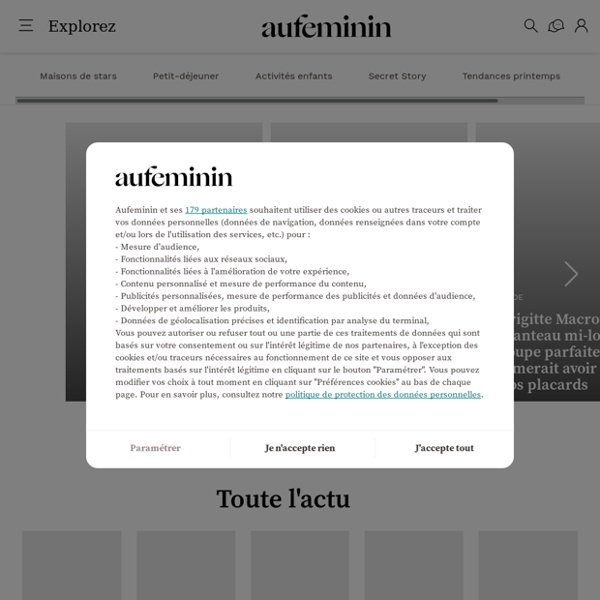



'I am a Feminist': New generation steps up to claim the 'F-word' mross@bayareanewsgroup.com These days, UC Berkeley senior Megan Riggio is proud to call herself a feminist. That wasn't always the case. EnvrAk portail des Chambres de commerce et d'industrie CFDEPour vous former sur l'environnement industriel et le développement durable OuiKiCommerceIdentifier et diffuser les bonnes pratiques entre les acteurs du commerce. EnvolLe management environnemental simplifié Les IDCLe logiciel Indices de Disparité des dépenses de Consommation: un outil d'aide à l'implantation commerciale AEFFichier national de plus de 2,5 millions d'entreprises des Chambres de Commerce. BachelorLabel attribué à des formations diplômantes reconnues par l'État, pilotées par les Chambres de Commerce et d'Industrie.
Santé Magazine : l'info santé et bien-être qui vous concerne "Do-Me" Feminism and the Rise of Raunch From the book Feminism and Pop Culture by Andi Zeisler. Excerpted by arrangement with Seal Press, a member of the Perseus Books Group. Copyright © 2008.
A Form of Western Shamanism Created by a Woman for Women Feminist Shamanism® is a sophisticated shamanic practice for women that engenders personal growth and the gradual development of shamanic consciousness. It guides contemporary women to remember who they are and what their sacred responsibilities entail as they reclaim their natural feminine power and authority. My latest writing project, “Shamanic First Aid for Today’s Woman,” is a purse-sized 80-page booklet, which you can use to begin exploring and using feminist shamanic teachings. It is rich with simple feminist shamanic fixes for common issues faced by today’s women.
A broken idea of sex is flourishing. Blame capitalism Since the Toronto bloodbath, a lot of pundits have belatedly awoken to the existence of the “incel” (short for involuntary celibate) online subculture and much has been said about it. Too often, it has been treated as some alien, unfamiliar worldview. It’s really just an extreme version of sex under capitalism we’re all familiar with because it’s all around us in everything, everywhere and has been for a very long time. From Circe to Clinton: why powerful women are cast as witches During the 2016 US presidential election, American social media was flooded with images of Hillary Clinton wearing a black hat and riding a broom, or else cackling with green skin. Her opponents named her The Wicked Witch of the Left, claimed they had sources testifying that she smelled of sulphur, and took particular delight in depictions of her being melted. Given that the last witch trial in the US was more than 100 hundred years ago, what are we to make of this? In the late 19th century, the suffragette Matilda Joslyn Gage asserted something revolutionary.
Damsel in distress The damsel in distress or persecuted maiden is a classic theme in world literature, art, film and video games. She is usually a beautiful young woman placed in a dire predicament by a villain or monster and who requires a hero to achieve her rescue. After rescuing her the hero can usually convince the woman to be their wife. 30 Things Every Woman Should Have and Should Know by the Time She's 30 If you haven't read the classic life-wisdom list, curl up and do it now—and let the well-known women on these pages keep you company. An exclusive excerpt from Glamour's new book, 30 Things Every Woman Should Have and Should Know by the Time She's 30. We all love a good list, and human history is full of them, from the Ten Commandments and the 95 Theses to the A-list and the best-dressed list. But until 1997, there was no list specifically for women (unless you count the 15 rules for serving your husband in The Good Wife's Guide…which we don't). That's when Glamour columnist Pamela Redmond Satran wrote "30 Things Every Woman Should Have and Should Know by the Time She's 30." Forwarded thousands of times from woman to woman and misattributed to Maya Angelou, Jesse Jackson, Hillary Clinton, and countless others, The List became a phenomenon.
Spare Rib Spare Rib was an active part of the emerging Women’s Liberation Movement in the late 20th century. Running from 1972-93, this now iconic magazine challenged the stereotyping and exploitation of women, while supporting collective, realistic solutions to the hurdles women faced. Visitors to this site can explore selected highlights from the magazine; and examine how the magazine was run, why it was started and the issues it dealt with. The full run of Spare Rib magazines can be accessed via Important information for researchers: from 7 June 2016, some material from the Spare Rib magazines on the journals archive site will be redacted until the Library is able to secure further copyright permissions.